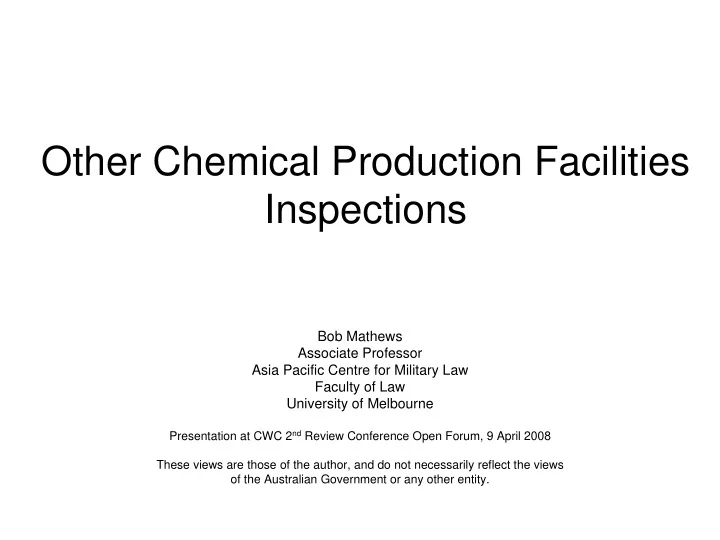

Other Chemical Production Facilities Inspections Bob Mathews Associate Professor Asia Pacific Centre for Military Law Faculty of Law University of Melbourne Presentation at CWC 2 nd Review Conference Open Forum, 9 April 2008 These views are those of the author, and do not necessarily reflect the views of the Australian Government or any other entity.
Outline of Presentation • Historical – Negotiation of OCPFs in Geneva • Experiences so far in OCPF inspections • Evolution of Chemical Industry – Globalisation – Advances in Science and Technology • The way ahead
Historical - Negotiation of OCPFs in Geneva • Mid-1980s – Concept of Schedule 1, 2 and 3 agreed. • National trial inspections – late 1980s – Multi-purpose production plants – Organophosphorus pesticide plants • Not producing Scheduled chemicals but could be readily adapted to. • CW-proliferation – late 1980s – Saddam’s Regime using MPPs and Pesticide plants • Therefore, by 1990, a ‘verification gap’ recognised. – Needed to go beyond Schedules 1,2, 3 – “CW-capable” = Other Chemical Production Facilities.
CW Production Facility
Selected Chemical Production Processes Production Process CW Agents Typical Commercial Products Sulphur-Mustard Insecticides Herbicides Chlorination Nitrogen-Mustard Lewisite Polymers, dyes Sarin Pharmaceuticals VX Solvents Polymers, solvents Fluorination Sarin Pharmaceuticals Soman Insecticides, herbicides Refrigerant gases Anasthetic gases Sarin Insecticides Esterification Tabun Solvents BZ Flavours Pharmaceuticals Tabun Insecticides Phosphorylation Sarin Flame retardants VX Oil additives Sarin Flame retardants Alkylation Soman Oil additives VX Petrochemicals
Historical - Negotiation of OCPFs in Geneva • Risk Assessment – Schedule 1 chemicals – ‘ a high risk’ – Schedule 2 chemicals – ‘a significant risk’ – Schedule 3 chemicals – ‘a risk’ In latter stage of negotiations, an attempt was made to consider relative risk posed by facilities producing Sch 1, 2, 3 chemicals and OCPFs. • But too difficult for Geneva conference room – e.g. how to compare a small lab producing 1g/year of Sarin with a multi-purpose pesticide plant producing 1000s of tonnes of pesticide that could readily produce Sarin – Decision taken by negotiators to leave such risk assessment to the future Technical Secretariat, based on their experiences in conducting industry inspections.
Historical - Negotiation of OCPFs in Geneva Final provisions of Article VI inspections • Phased implementation – Schedule 1 inspections – initial inspection within 180 days – Schedule 2 inspections – initial inspection within 3 years – Schedule 3 inspections – OCPF inspections – no inspections before of 4 th year after EIF • Flexibility in Article VI – beyond initial inspections of Sch 1 and 2 facilities, verification procedures designed to be open to future adjustments in light of practical experiences and developments in industry, with: – Risk assessment by Technical Secretariat; – Allocation of resources to particular types of inspections by CSP • Simplified technical change possible under Article XV
Experiences so far in OCPF inspections • More than 500 OCPF inspections since 2000* – 11% of overall OPCW inspections – Overall OCPF inspections have gone well. • BUT – In some States Parties, <1% of OCPFs inspected – Random Selection processes – difficulty in achieving ‘equitable geographic distribution’ – Not all OCPF inspection sites were ‘relevant’ • insufficient information in declaration format (‘Main Activities’) – TS assessment is that ‘the level of OCPF inspections still does not provide adequate non-proliferation assurances’ (RC-2/DG.2) [* N.B. compared with more than 800 Sch 1,2,3 inspections]
Evolution of Chemical Industry • Increasing globalisation of chemical industry – Increased production at ‘non-traditional production locations’. • Increasing flexibility in plant site design – multipurpose facilities. • Advances in Science and Technology, including: – Better understanding of, and ability to manipulate, ‘life processes’; – Production of chemicals through ‘biological processes’; and – Microreactors • May lead to novel routes to Schedule 1 chemicals; and • Other novel toxic chemicals.
OCPFs - The way ahead (1) • OCPF Workshop for OPCW delegates – Including visit to an OCPF – Increased awareness of OPCF issues • Adjustment to Declaration Format – to include more information on ‘main activities’ • production processes • dedicated or multipurpose • Greater allocation of resources to OCPF inspections • Improvement in OCPF selection methodology – for ‘equitable geographic distribution’ and ‘high risk’ facilities
OCPFs - The way ahead (2) • Training of Inspection Teams – Inspectors need ‘cutting edge’ knowledge of advances in S&T. • Sampling and Analysis for OCPF inspections – after further experience gained with Sch 2 S&A inspections, and – further development of on-site analytical capability. • Down the track, consider whether OCPF regime needs refinement through Article XV, based on: – Additional inspection experiences; – Development and Evolution of chemical industry; and – Advances in S&T.
Recommend
More recommend